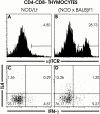alpha/beta-T cell receptor (TCR)+CD4-CD8- (NKT) thymocytes prevent insulin-dependent diabetes mellitus in nonobese diabetic (NOD)/Lt mice by the influence of interleukin (IL)-4 and/or IL-10
- PMID: 9529321
- PMCID: PMC2212199
- DOI: 10.1084/jem.187.7.1047
alpha/beta-T cell receptor (TCR)+CD4-CD8- (NKT) thymocytes prevent insulin-dependent diabetes mellitus in nonobese diabetic (NOD)/Lt mice by the influence of interleukin (IL)-4 and/or IL-10
Abstract
We have previously shown that nonobese diabetic (NOD) mice are selectively deficient in alpha/beta-T cell receptor (TCR)+CD4-CD8- NKT cells, a defect that may contribute to their susceptibility to the spontaneous development of insulin-dependent diabetes mellitus (IDDM). The role of NKT cells in protection from IDDM in NOD mice was studied by the infusion of thymocyte subsets into young female NOD mice. A single intravenous injection of 10(6) CD4-/lowCD8- or CD4-CD8- thymocytes from female (BALB/c x NOD)F1 donors protected intact NOD mice from the spontaneous onset of clinical IDDM. Insulitis was still present in some recipient mice, although the cell infiltrates were principally periductal and periislet, rather than the intraislet pattern characteristic of insulitis in unmanipulated NOD mice. Protection was not associated with the induction of "allogenic tolerance" or systemic autoimmunity. Accelerated IDDM occurs after injection of splenocytes from NOD donors into irradiated adult NOD recipients. When alpha/beta-TCR+ and alpha/beta-TCR- subsets of CD4-CD8- thymocytes were transferred with diabetogenic splenocytes and compared for their ability to prevent the development of IDDM in irradiated adult recipients, only the alpha/beta-TCR+ population was protective, confirming that NKT cells were responsible for this activity. The protective effect in the induced model of IDDM was neutralized by anti-IL-4 and anti-IL-10 monoclonal antibodies in vivo, indicating a role for at least one of these cytokines in NKT cell-mediated protection. These results have significant implications for the pathogenesis and potential prevention of IDDM in humans.
Figures



References
-
- Bendelac A, Rivera MN, Park S-H, Roark JH. Mouse CD1-specific NK1 T cells: development, specificity and function. Annu Rev Immunol. 1997;15:535–562. - PubMed
-
- Makino S, Kunimotot K, Muraoka Y, Mizushima Y, Katigiri K, Tochino Y. Breeding of a nonobese diabetic strain of mice. Exp Anim. 1980;29:1–13. - PubMed
-
- Zipris D, Lazarus AH, Crow AR, Hadzija M, Delovitch TL. Defective thymic T cell activation by concanavalin A and anti-CD3 in autoimmune nonobese diabetic mice. J Immunol. 1991;146:3763–3771. - PubMed
-
- Gombert J-M, Herbelin A, Tancrede-Bohin E, Dy M, Chatenaud L, Carnaud C, Bach J-F. Early defect of immunoregulatory T cells in autoimmune diabetes. CR Acad Sci Paris. 1996;319:125–129. - PubMed
Publication types
MeSH terms
Substances
LinkOut - more resources
Full Text Sources
Other Literature Sources
Medical
Research Materials

